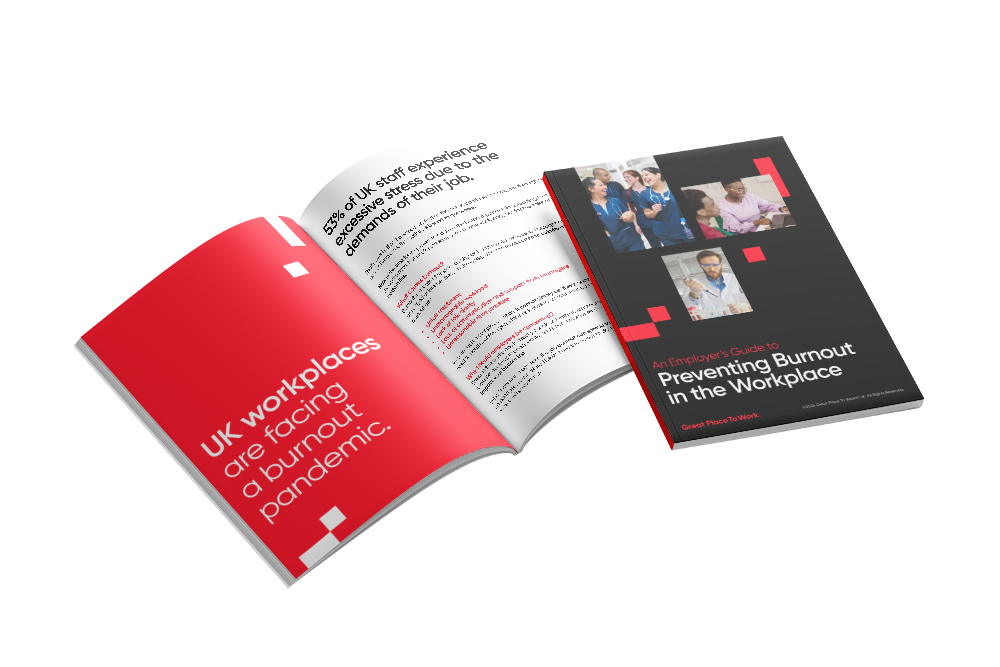“The key isn’t to eliminate stress entirely (after all, some levels of eustress can be beneficial). This is about enhancing the wellbeing and resilience of your leaders, allowing them to be efficient, healthy and thrive – even when under immense pressure.”
~ Sara Silvonen, Workplace Wellbeing Specialist
Dealing with work-related stress is critical to employee health.
It's also essential for business finance, team engagement and the quality of your customer service. Yet despite evidence indicating direct links between wellbeing and business performance, many companies still fail to treat the root causes of stress and develop flexible practices that can fulfil a variety of needs experienced by individual employees.
In our 2020 European pulse, we asked more than 900 HR directors, managers and specialists to share their views on issues around work-related stress and the wellbeing practices in their workplace.
Over half (51%) of those surveyed agreed that excessive pressure to deliver affects senior managers’ mental health, with support for executives struggling to cope with stress most commonly found in the construction (63%), financial services (62%) and social service (60%) industries.
EU-OSHA (2014) reported that the total cost of mental ill health in Europe is €240 billion per year. Of this, €136 billion is the cost of reduced productivity including sickness absence, and €104 billion is direct costs such as medical treatment.
Productivity loss from presenteeism may in fact cost twice that of absenteeism – warning against a culture of workaholism and long hours.
Our study found that on average 52% of European HR professionals reported their organisations to have mechanisms in place to support their executives experiencing stress, but only 24% reported mechanisms to measure stress levels in the first place.
For the UK specifically, two-thirds of organisations (66%) said that health and wellbeing emerged as a strategic business priority, but only 35% reported executive stress being a key issue in their organisation.
With more managers working remotely and businesses confined to various levels of lockdown across the country, executives’ stress levels are likely to remain high.
So what are key causes of stress for executives, and how can HR teams help to improve their wellbeing?
Key stressor #1: Pressure to deliver
Executive stress derived from expectations around deliverables or targets is particularly prevalent in Europe’s health care sector (64%), industrial services (63%) and manufacturing (59%) industry.
Leadership coaching can be an effective tool to help managers thrive, especially at a time when many are navigating uncertainty, or suddenly forced to take on increased responsibility due to redundancies occuring in the organisation.
AbbVie – one of 2021's UK’s Best Workplaces™ for Women – offers a ‘Coach to Lead’ programme for all managers and leaders of the business. Each leader receives phone coaching with an individually matched coach, working on any topic that the employee decides and is tied to the AbbVie Ways of Working. Having experienced great coaching, the programme aims to further develop the coaching skills of those leaders to use with their own teams.
The company also has a proactive ‘Aspiring Leader Development Centre’ for individuals who are 0-2 years from becoming a manager. These employees can take a number of modules spaced out over several weeks, aimed at building capabilities such as emotional intelligence, coaching for performance and managing workload.
Individuals receive developmental feedback and a customised development plan to continue building their leadership skills. Leader onboarding and transition support are also provided through a toolkit, as well as a guide of proposed activities for the first 90 days.
Key stressor #2: Longer hours
Working significantly longer hours is a common constant practice at executive level.
When reviewing the 13 countries in our survey, their performance in Eurostat’s annual study of working hours in Europe suggests that traditional working hours are fairly consistent across borders.
For the last two years in Europe, the average continues to be 40.4 weekly working hours. Turkey leads with the highest total (48.5 hours per week) while Denmark, on the other end of the spectrum, sits at only 37.8 weekly hours.
Longer hours are more common in larger organisations than in SMEs. However, UK’s Best Workplaces™ are proving that this doesn’t have to be the case, even when they faced with 1000+ employees.
In 2019, Hilton’s Emergency Cover Support model supported employees when they needed to take unplanned time off work due to, for example, sickness of a child. Managers with children under 5 sign up to the model and if they require short-term unexpected leave from work, their colleagues within the Support Network are called upon to support their hotels in their absence.
Increased flexibility in working hours – particularly for working parents or employees who have the added challenge of caring responsibilities – can also help decrease chronic stress.
By giving managers autonomy in developing a schedule that meets their work-life balance needs, organisations promote that good work is determined by the quality of one’s outputs, not by how many hours people work.
How surveys can help
The first step to a better wellbeing strategy is to recognise, understand and measure the factors that directly impact everyday wellbeing of all employees – including executives.
Postponing surveys erodes trust and risks the organisation investing in programmes that won’t enable everyone to flourish on a personal level.
The good news is that senior leaders themselves have the ability to help boost your wellbeing strategy by explicitly making wellbeing a strategic priority and allocating appropriate investment towards it.
With the right employee survey platform, your HR leaders can create customised pulse surveys or polls to get feedback in real-time from their SMT.
And the cherry on top: the survey itself takes just a few minutes for leaders to complete.
Whatever the style or format of your surveys, the key isn’t to aim for eliminating stress entirely (after all, some levels of eustress can be beneficial). This is about enhancing the wellbeing and resilience of your leaders.
By providing them with effective stress management techniques, you'll allow senior leaders to be efficient, healthy and thrive – even when under immense pressure.






